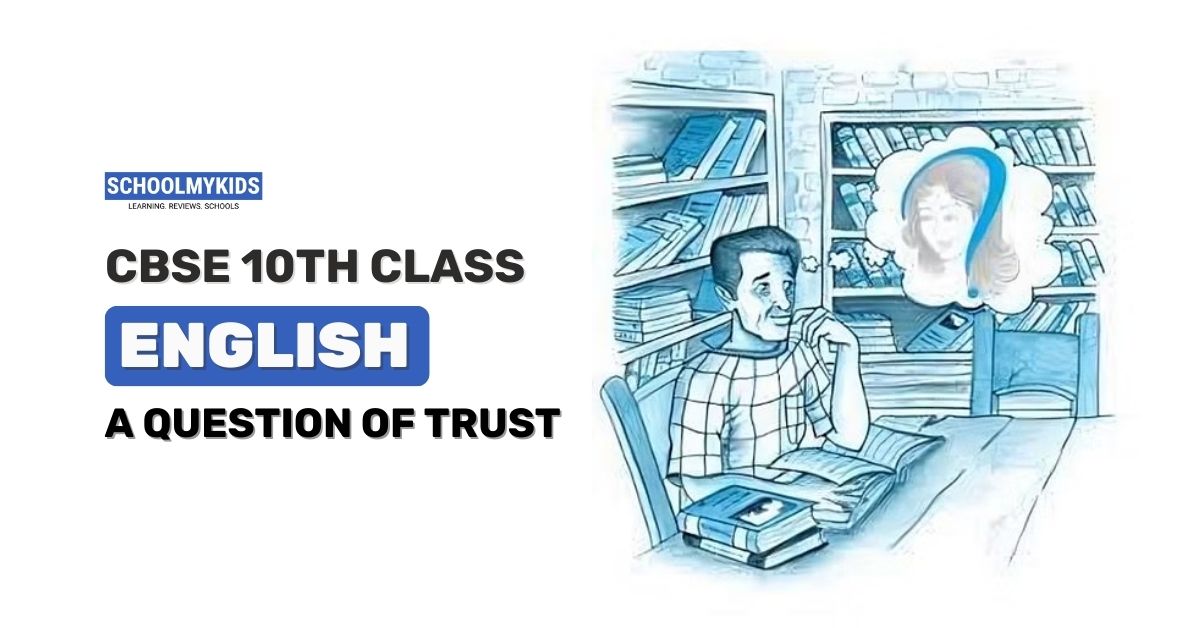Summary
“A Question of Trust” is a captivating short story by Victor Canning, featured in the CBSE Class 10 English curriculum. This engaging narrative centers around Horace Danby, a 50-year-old man who leads a double life. By day, he runs a successful lock-making business, portraying himself as a respectable, law-abiding citizen. By night, he is a meticulous and professional burglar who steals valuable items from wealthy homes.
The story unfolds with Horace planning his next heist at Shotover Grange, a luxurious mansion with a safe full of precious jewels. On a bright July morning, Horace confidently makes his way to the mansion, having meticulously planned every detail of the burglary. As he enters the house, he feels a thrill and satisfaction from the challenge and the prospect of acquiring the valuable jewels.
However, his plans are unexpectedly thwarted when he encounters a woman dressed in red, who claims to be the lady of the house. She catches him red-handed but, instead of calling the police, convinces Horace to open the safe for her by pretending she has forgotten the combination. Horace, charmed by her demeanor and convinced by her story, opens the safe and hands over the jewels.
Later, Horace realizes he has been deceived when he learns from the real owners that the woman was an imposter. The irony of his situation is stark—being a professional burglar, he is outsmarted by someone using his own trust against him. Horace ends up in prison, reflecting on how he was fooled by the very tactics he relied on.
Analysis
“A Question of Trust” delves into themes of deception, irony, and the human inclination to trust those who seem trustworthy. The story serves as an excellent example of how appearances can be deceiving and how even the most well-thought-out plans can be derailed by unforeseen circumstances.
The central theme of the story is trust and betrayal. Horace Danby, despite being an experienced burglar, falls victim to his own trust in the woman’s deceptive appearance and convincing story. This highlights the vulnerability inherent in even the most cautious individuals when confronted with a well-crafted lie.
Victor Canning skillfully uses irony to enhance the story’s impact. Horace, who prides himself on his intelligence and meticulous planning, is ultimately deceived by someone using the very tools of deception he relies on in his burglaries. This twist underscores the unpredictability of human behavior and the risks of underestimating others.
The story also delves into the psychology of crime, presenting a protagonist who, despite his criminal activities, adheres to a personal code of ethics. Horace’s character is complex; he is both a meticulous planner and a man who values trust, which ultimately leads to his downfall.
Important Questions with Explanations
- What is the central theme of “A Question of Trust”?
- The central theme is trust and betrayal. The story explores how trust can be manipulated and how appearances can be deceiving.
- Describe Horace Danby’s character.
- Horace Danby is a 50-year-old burglar who leads a respectable life as a lock-maker. He is meticulous in planning his heists and has a personal code of ethics, stealing only once a year.
- How does the woman in red deceive Horace?
- The woman pretends to be the lady of the house and convinces Horace to open the safe for her by claiming she has forgotten the combination. Her convincing demeanor and appearance deceive Horace.
- What is the significance of the story’s title, “A Question of Trust”?
- The title reflects the core issue of the story—Horace’s misplaced trust in the woman, which leads to his downfall. It highlights the theme of trust and deception.
- How does irony play a role in the story?
- Irony is central to the story as Horace, a professional burglar who prides himself on his intelligence, is outsmarted by a woman using his own methods of deception.
- What lesson does Horace Danby learn by the end of the story?
- Horace learns that even the most carefully laid plans can fail if one is not cautious about whom to trust. His experience teaches him the unpredictability of human behavior.
- How does the setting contribute to the story’s suspense?
- The setting of Shotover Grange, an isolated mansion, creates a backdrop of suspense and tension, emphasizing the high stakes of Horace’s burglary.
- What role does the woman’s appearance play in deceiving Horace?
- The woman’s appearance, dressed elegantly in red and acting with confidence, plays a crucial role in convincing Horace that she is the lady of the house.
- Analyze the character of the woman in red.
- The woman in red is cunning, manipulative, and quick-thinking. She skillfully uses her appearance and acting to deceive Horace, showcasing her intelligence and opportunism.
- Discuss the theme of deception in “A Question of Trust”.
- Deception is a key theme as the woman deceives Horace into opening the safe. The story illustrates how easily one can be fooled by appearances and convincing lies.
- What is the impact of Horace’s personal code of ethics on the story?
- Horace’s code of ethics makes him a more complex character and adds depth to the story. It highlights the irony of a thief who trusts others and values certain moral principles.
- How does Victor Canning create suspense in the story?
- Canning creates suspense through detailed descriptions of Horace’s meticulous planning and the unexpected twist of the woman’s deception.
- What does the story suggest about human nature and trust?
- The story suggests that human nature is complex and that trust can be both a strength and a vulnerability. It highlights the risks of placing trust in the wrong people.
- How does Horace’s profession as a lock-maker relate to the story’s themes?
- Horace’s profession as a lock-maker symbolizes his expertise in security, yet he fails to secure his own trust, underscoring the story’s theme of deception.
- What is the significance of Horace’s meticulous planning?
- Horace’s meticulous planning highlights his intelligence and professionalism, making his ultimate deception by the woman even more ironic and impactful.
- How does the twist at the end of the story affect the reader?
- The twist surprises the reader and reinforces the story’s themes of deception and irony, leaving a lasting impression about the unpredictability of trust.
- What role does the setting of Shotover Grange play in the plot?
- Shotover Grange serves as the perfect setting for the burglary, with its isolation and wealth, adding to the tension and suspense of Horace’s heist.
- Analyze the narrative style of Victor Canning in “A Question of Trust”.
- Canning’s narrative style is straightforward and detailed, building suspense through Horace’s actions and thoughts, and delivering a powerful twist at the end.
- How does the story explore the concept of moral ambiguity?
- The story explores moral ambiguity through Horace’s character, who, despite being a thief, has his own set of principles, blurring the lines between right and wrong.
- What overall message does “A Question of Trust” convey?
- The story conveys that trust should be carefully placed and that appearances can be deceptive. It emphasizes the importance of being cautious and the potential consequences of misplaced trust.
Conclusion
“A Question of Trust” by Victor Canning is a compelling story that delves into themes of deception, irony, and the human tendency to trust those who appear trustworthy. Through the character of Horace Danby, the story highlights how appearances can be misleading and how even the most meticulously planned schemes can fail.









Be the first one to comment on this story.